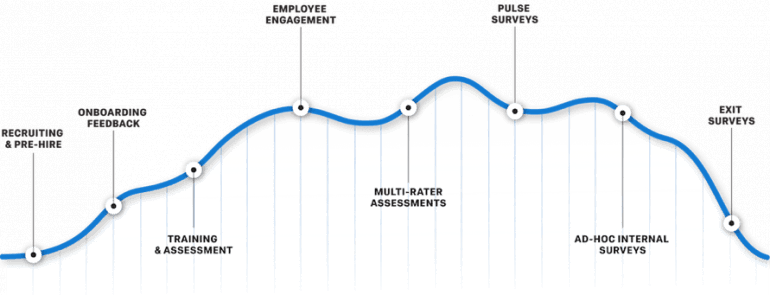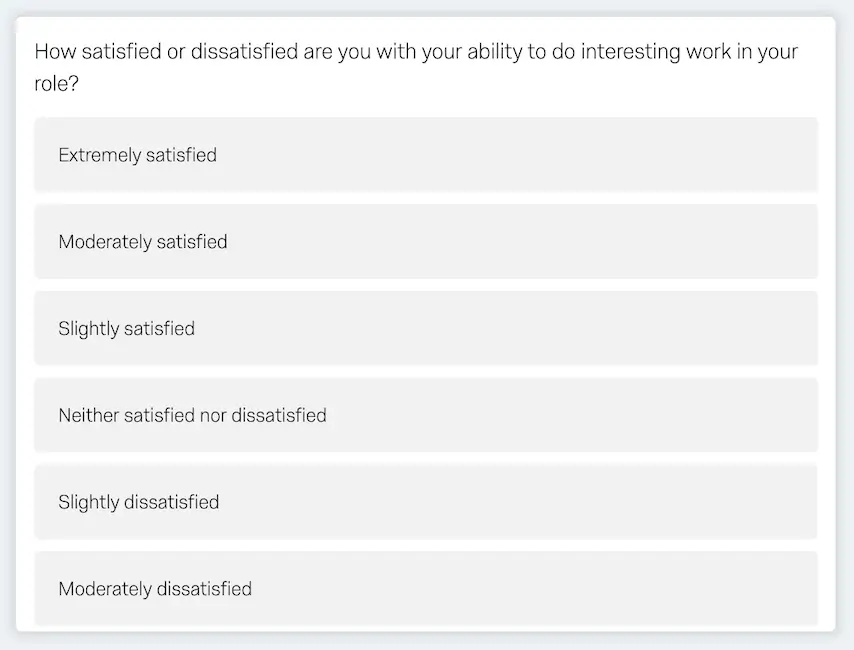
Employee Experience
Employee satisfaction surveys: What are they, best practices and sample questions
Updated October 30, 2024
When it comes to measuring job, work-life balance, or employee satisfaction, surveys are a powerful solution. All the resources you need to succeed are here in our guide — use them strategically to unlock deep insights into the experience of your staff that will help employee retention, boost performance, and nurture the company’s culture.
Let's look at the best practices and sample employee survey questions below.
Get started with our free employee satisfaction survey template
What is an employee satisfaction survey?
An employee satisfaction survey, also called a job satisfaction survey, is an employee feedback tool that allows employers to find out about the employee experience, directly from employees themselves.
Until recently, an employee opinion survey was typically a major annual event. But employers now recognize that to capture and improve the full employee experience — which goes beyond employee satisfaction and engagement — requires gathering data in various forms and at various points in the employee lifecycle.
For much of this measurement, ESAT survey questionnaires are the perfect tool. Employee satisfaction survey questionnaires can be long, short, in-depth, or in the moment, and they provide a standardized framework that employers can use to measure and track how engaged at work employees are over time.
From employee satisfaction to engagement
Reducing turnover and improving employee satisfaction has been a goal of organizations since at least the 1930s, when psychologists began earnestly studying employee attitudes and productivity, and how they were affected by the employer-employee relationship. At this time, a “job satisfaction” employee survey came about, which then became the norm for the next 50 years and evolved over time to be more complex and sophisticated.
By the early 1990s, HR professionals learned that just being “satisfied” isn't enough to motivate employees to really unlock their full value within the organization. Employers needed a new way to get to the heart of how people were feeling about their company, and how much effort they were prepared to put in as a result. This measure of connection and effort was named “employee engagement,” and has since become the industry best practice for an employee survey.
“The way your employees feel is the way your customers will feel. And if your employees don’t feel valued, neither will your customers.”
- Sybil F. Stershic, Taking Care of the People Who Matter Most: A Guide to Employee-Customer Care
Benefits of an employee satisfaction survey
- Employee satisfaction increases business productivity: When your employees are engaged, employees feel valued. They believe in the work they do and want to go above and beyond to be successful. Employees feel that’s when work doesn’t really feel like work. Imagine a company full of employees who feel like that — how many employees would be satisfied employees? With the right direction and guidance, a workforce full of engaged employees can be unstoppable. It’s no surprise that this has become such a crucial measure for organizations.
- Reduce employee turnover: When you retain your employees, you’re retaining the knowledge, investment, and value that these employees bring to the business. One key factor that employees want is a good culture, good working conditions, and satisfaction in their job. The results of the survey would give management vital information about how to direct HR resources, and give employees the message that management is listening to their feedback.
- Transform the company into a happier place: Having a good environment to work in will give employees the right circumstances to thrive in. If you’re getting continuous feedback from your employees, you can help create a great employee experience within your organization.
“To win in the marketplace you must first win in the workplace.”
- Doug Conant, CEO of Campbell’s Soup
Measuring engagement with employee satisfaction surveys
How do you measure employee satisfaction? To capture and improve the full employee experience requires gathering data in various forms and at various points in the employee lifecycle.

For much of this measurement, employee engagement surveys are the perfect tool.
Below, we’ve outlined a more traditional approach to engagement surveys — suitable for one-off, annual, or semi-annual surveys. While there is not a one-size-fits-all solution to running an engagement survey, this type of comprehensive approach serves as the foundation from which any employee satisfaction survey can be built.
Employee engagement survey questions & best practices
Want to build your own bespoke employee satisfaction survey? Here are the major principles for designing employee surveys.
Employee surveys: Tips for getting started
Before you begin building your employee satisfaction survey, consider these five guidelines:
- Decide which stakeholders need to provide input.
- Set clear deadlines and turnaround times before starting.
- Give one person final sign-off authority and clearly communicate that person as the decision maker.
- Scrutinize every new employee feedback survey and be sure to distinguish ‘nice to have’ questions from ‘must have’ questions.
- Try to avoid designing your survey by committee.
Employee satisfaction survey structure
An employee satisfaction survey isn’t just a questionnaire, it’s a diagnostic tool that will drive employee experience analysis and action. A great survey brings principles of organizational psychology and applies them to your company and company culture. For that reason, it’s important to have a strong survey structure. To that end, we recommend dividing your employee satisfaction survey into three types of “item banks,” all with a clear purpose:
- Item Bank 1: measuring engagement. Your engagement items combine into one metric that tells you how you’re doing and allows you to track progress over time. These items measure pride, enthusiasm for work, discretionary effort, advocacy, intent to stay, and overall job satisfaction.
- Item Bank 2: measuring what drives engagement. These items ask about the conditions that might cause or detract from engagement. In essence, they can tell you what you’re doing well and what you can do to improve. Companies may measure how well employees share knowledge, cooperate on work within and across team members, and the extent to which collaboration is encouraged and rewarded.
- Item Bank 3: open-ended comments measuring what’s on your employees' minds. Open-ended items provide richer employee data, allowing you to dive deeper and understand employee feedback that you may not have known to look for. These can both be asked as a follow-on to driver items, or as general open-ended input at the end of the employee survey.
Here is an example of what employee satisfaction survey questions can look like using a response scale:

Employee satisfaction survey length
There is no ideal length for an employee satisfaction survey; the individual needs of your organization should determine the length of your survey. In fact, the key is to find a balance between asking enough questions to be robust, and not asking so many questions that your employee satisfaction surveys become too long (with data too complicated to digest in reports). This way employees spend less time filling one in.
As a general rule, assuming you’re running an annual engagement diagnostic plan and not a pulse survey, we advise limiting your survey to around 40 questions.
In order to cull questions in your employee satisfaction survey, ask yourself the following:
- Are we really prepared to act and make changes based on this question?
- Is this question repeating something we already asked in another question on the survey?
- Does this question actually tell us something useful that benefits the company, as opposed to just something interesting?
- Is this question relevant to all parts of the business?
- Is this a topic more suited for a pulse, ad hoc, or lifecycle study?
Writing employee satisfaction survey questions
When writing a survey question, here are just a few examples of the goals to keep in mind:
- Ensure clarity by only mentioning a single subject or construct — failure to do this can result in “double-barreled” questions. For example, “How satisfied or dissatisfied were you with our product selection and quality?” is a problematic question because it mentions two subjects: the selection, and the quality of products. A respondent may feel extremely satisfied with the quality of the products but extremely dissatisfied with the selection. For that respondent, it’s unclear how to respond to the question. A better approach would be to create separate questions to address each construct.
- Have the question mean the same thing to all respondents — each respondent should interpret the meaning of the question identically. If respondents have different interpretations of the meaning of the question, the resulting data will be invalid because it will be impossible to determine what question each respondent thought they were answering. For example, people may have a different idea of what a ‘good work-life balance’ is.
- Use words economically. It’s important to use as many words as are needed to convey the idea of the question clearly, but additional words introduce more elements that could potentially confuse respondents. Keeping questions short also means that respondents can read them more quickly, which should help keep the staff satisfaction survey duration short.
For word choice specifically, there are a few things to keep in mind. First, words used in the employee satisfaction survey questions should have only one meaning (this is easy to verify with a dictionary). Additionally, words and sentences should be simple, to maximize ease of reading and comprehension. A useful rule of thumb is that words with fewer syllables, and sentences with fewer words, are typically simpler. Readability scores calculated with online tools are often useful for assessing the complexity of the words and sentences that form a question.
The conventional wisdom — which has been supported by most empirical research on the topic over the years — suggests that, in general, questions should be worded to:
- Be simple, direct, comprehensible
- Be actionable (Meaning: if you read the statement, based on the results, it should be clear who and how can make change against it.)
- Be specific and concrete (rather than general and abstract)
- Avoid jargon
- Avoid double-barreled questions
- Avoid negations
- Avoid leading questions
- Avoid emotionally charged words
- Be read smoothly out loud
- Allow for all possible responses
If you follow these recommendations, it is much less likely that your survey questions will confuse or frustrate your respondents, and your data are more likely to be valid and reliable.
Sample top questions for employee satisfaction survey questions
Here are some examples from Qualtrics Employee Experience items, organized by category. These categories of items have been shown to be core drivers of engagement:
| Category | Definition | Success Criteria | Example Questions |
|---|---|---|---|
| Collaboration | Employees' ability to easily work together, share knowledge, and cooperate within and across teams and team members. | My manager encourages collaboration on my team
The people I work with cooperate to get the job done |
Does your manager promote teamwork as a value? Do you get opportunities to collaborate at work? Who are the people you collaborate with the most? |
| Communication | Employees' access to enough information from the company and issues that affect them. | I receive the information I need to do my job effectively There is open and honest communication at this company |
Is there clear access to the information you need for your job role? Is there transparency with information across the company? |
| Company Leadership | Employees' confidence and trust in senior leaders' actions. | I have confidence in the senior leadership team to make the right decisions for this company The behavior of our senior leadership team is consistent with this company's values |
How confident are you in your manager’s ability to represent your needs? Do you think your leaders demonstrate the company values? |
| Customer Focus | Employees' involvement in a customer-centric company and empowerment to do what's needed. | Customer problems and concerns are dealt with quickly I am empowered to make decisions to best serve my customers |
How empowered do you feel to engage with customers in your role? Do you feel able to provide support to customers with your current level of training? Are you able to respond quickly to customer concerns? |
| Engagement | Employees' feelings of a connection to their work and the company. Note: engagement is an outcome measure. |
I am proud to work for this company My work gives me a feeling of personal accomplishment |
How likely are you to recommend this company to others? Do you enjoy your role? Do you feel a sense of personal accomplishment from your job? |
| Personal growth & Career Development | Employees' feel supported in their development and building a career at the company. | Overall, I feel that my career goals can be met at this company This company provides me with the opportunity for learning, development and personal growth |
Do you have a career development plan? What support from management is available to help you develop your skills? Do you get encouragement from management to train? |
| Inclusion | Employees' feelings that they are a part of the team and company, are valued, and that their opinions matter. | Diverse perspectives are valued and encouraged in my team I am comfortable voicing my ideas and opinions, even if they are different from others |
Do you feel your manager listens to your ideas and takes them on? Do you feel encouraged to suggest your ideas and opinions? |
| Job Enablement | Employees' feelings that they have the resources and support to be effective in their role. Note: Job Enablement is an outcome measure. |
My job is challenging and interesting I have the authority I need to do my job |
How challenging is your work? Do you feel your work is interesting? Do you believe you have enough authority to complete your job? |
| Performance & Accountability | Employees' understanding of their goals and expectations, empowerment to accomplish their work, recognition for their contributions and demonstration of accountability. | At this company, people are held accountable for their performance I receive feedback that helps me improve my performance |
Do you have regular meetings with your manager where they share feedback? Is the feedback presented in a constructive way? Do you have a clear understanding of your goals and targets? |
| Strategic Alignment | Employees' understanding of the company's direction and connection between their work, the work of other teams, and to what is important to the company. | I can see a clear link between my work and this company's strategic objectives Senior leadership gives employees a clear picture of the direction our company is headed |
● Is there a clear understanding of how your work reflects on the company’s strategic goals? ● Do you get information from management about the direction of the company? |
| Survey Follow-Up | Employees' belief in and experience of actions taken based on prior survey results. | I am confident that action will be taken as a result of this survey. I believe that positive change will happen as a result of this survey |
How confident are you that action will be taken based on the results of this survey? Do you think the company is able to make positive changes? |
| Work Processes | Employees' focus on quality, and encouragement to continuously improve and try new things in their work. | I am encouraged to come up with better ways of doing things Work is well-coordinated on my team |
Does your manager promote high quality as a value? Do you get opportunities to improve processes or policies? How coordinated is your work from your manager? |
How to get started
If you're looking to get started impacting employee morale and promoting work-life balance immediately, download our free employee engagement survey template below. For advanced strategic help or a more in-depth walk-through, book a free demo today with our employee experience product experts.
Get started with our free employee engagement survey template